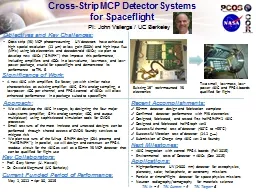PPT-Objectives and Key
Author : olivia-moreira | Published Date : 2017-11-03
Challenges Cross strip XS MCP photoncounting UV detectors have achieved high spatial resolution 12 µm at low gain 500k and high input flux MHz using lab electronics
Presentation Embed Code
Download Presentation
Download Presentation The PPT/PDF document "Objectives and Key" is the property of its rightful owner. Permission is granted to download and print the materials on this website for personal, non-commercial use only, and to display it on your personal computer provided you do not modify the materials and that you retain all copyright notices contained in the materials. By downloading content from our website, you accept the terms of this agreement.
Objectives and Key: Transcript
Download Rules Of Document
"Objectives and Key"The content belongs to its owner. You may download and print it for personal use, without modification, and keep all copyright notices. By downloading, you agree to these terms.
Related Documents














